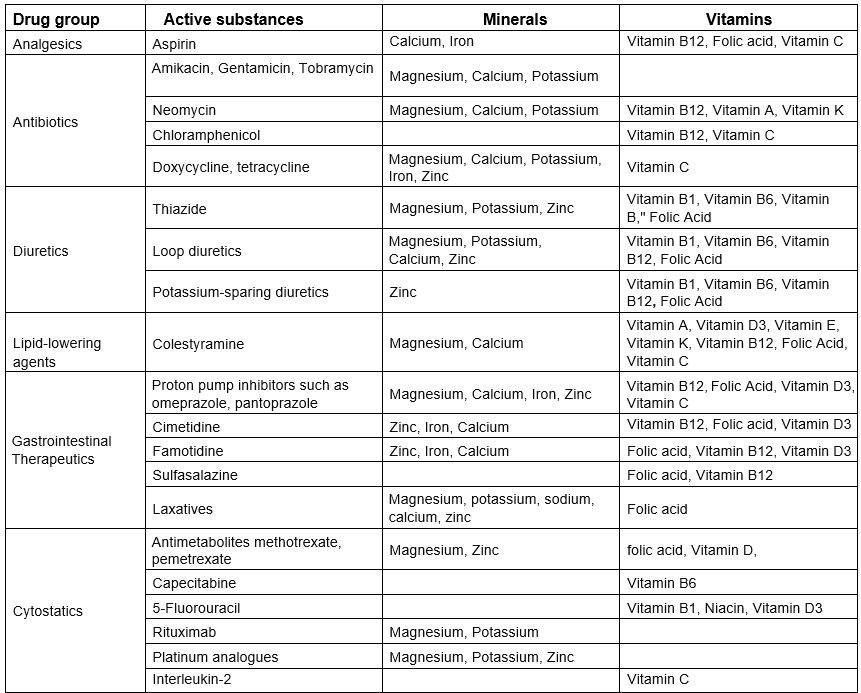A Cancer Therapy Special
Biofactors in Cancer
What They Can Do
For those in a hurry
Many tumor patients suffer from food aversions, taste and digestive disorders and can therefore fall into malnutrition. The targeted use of individual, scientifically tested biofactors as approved drugs can complement and support oncological therapy.
Supplementing conventional oncological therapy with a change in diet or supplementation with biofactors such as vitamins, minerals and trace elements is generally to be welcomed. The success of the therapy depends not insignificantly on the nutritional and biofactor status of affected patients. Nevertheless, there are a few things to consider.
While in earlier years the opinion was represented that calorie restriction – but without malnutrition – increases the life expectancy of cancer patients and reduces the tumor rate(1), today it is known that 20-30% – sometimes even up to 60% – of cancer patients do not die from the underlying disease, but rather from the consequences of associated malnutrition(2). Many of those affected suffer from anorexia with inappetence, food aversions, taste and digestive disorders and can thus fall into malnutrition and, in the worst case, tumor cachexia.
Avoiding Biofactor Deficiencies in Cancer Patients
What are the consequences of malnutrition? The body’s immune system and organ and metabolic functions are weakened. An increased rate of complications, for example due to inflammation, secondary infections, sepsis and a prolonged hospital stay, is possible. The factors that lead to malnutrition do not only concern the energy-providing carbohydrates, proteins and fats. A deficiency of biofactors that have a biocatalytic and immunomodulatory effect must all also be taken into consideration:
- Biofactors are involved in metabolic processes and enzyme reactions and have important tasks in the body’s own systems(3).
- In the context of cancer illnesses a good supply of vitamins and minerals can help to strengthen the immune system or have an immunomodulating effect, inhibit inflammation, promote regeneration and, last but not least, improve the quality of life of those affected.
- Another aspect of a good supply of vitamins, etc. is the reactivation of the immune system in the vicinity of the tumor so that the immune cells can recognize and destroy the tumor as such.
Scientifically proven biofactors can be used as approved drugs to complement oncological therapy.
Only Substitute Focused Biofactors
Depending on the patient’s individual care at the beginning of their illness and the storage capacity of individual vitamins and minerals, a biofactor deficiency can occur differently either very quickly or also very pronounced.
With regard to compensating for such a biofactors deficiency however, it is not about self-medication by the patient without therapeutic accompaniment. It is also not about an all inclusive intake of nutritional supplements, according to the watering can principle. And above all, it is not about a holistic alternative to conventional cancer treatment; biofactors cannot replace surgery, chemotherapy or radiation therapy. Rather, it is about supplementation adapted to the individual course of the disease, i.e. the focused use of individual, scientifically tested biofactors that can supplement and support oncological therapy as approved drugs. Therefore, if a biofactor deficiency is suspected, a careful anamnesis, examination and diagnostics are recommended to confirm this suspicion and then compensate for a deficiency(4).
Background Information:
S3 Guideline for Complementary Medicine in the Treatment of Oncological Patients
Here it says: “There are insufficient data from randomized, placebo-controlled studies available to assess the efficacy of high-dose intravenous vitamin C, in prolonging overall or progression-free survival or reducing toxicity in oncological patients in tumor therapy or secondary prevention. No recommendation can be made for or against the use of high-dose intravenous vitamin C in these patients.” (24)
Drugs Instead of Nutritional Supplements
“Unfortunately, many people are not aware of the difference between a nutritional supplement and a drug.” Prof. Jutta Hübner, Professor of Integrative Oncology at Jena University Hospital emphasized this connection in an interview with the German Cancer Society(5). “There is a widespread assumption that nutritional supplements are tested in the same way as medicines before they reach the market. However, this is not the case. Only for medicinal products must the safety and efficacy be proven before they are approved.”
Prof. Hans Georg Classen, physician for pharmacology and toxicology and chairman of the Society for Biofactors (GfB), also warns: “Although the supply of biofactors in tumor patients is often inadequate, those affected should be warned about an all-inclusive intake of nutritional supplemnts.” Here in the S3 Guideline for Complementary Medicine in the Treatment of Oncological Patients it says: “Serum levels should be determined for the following components of supplements and substitutes: Vitamin B12, D3, and selenium. Further a serum level determination should take place, provided that within the scope of the supplementation the recommended dose of the German Society for Nutrition is specifically surpassed or if a long term intake is planned.”(6)
Without proof of deficiency or pharmacological benefit, non-specific supplementation holds yet another risk. Potential interactions with drugs necessary for the cancer patients should not be underestimated. Under certain circumstances, desired therapeutic effects of tumor treatment can be slowed down or prevented.
Background Information:
Nutritional Supplement Versus Drug
Nutritional supplements are classified as foodstuffs and are reported to the Federal Office of Consumer Protection and Food Safety (BVL) before they are placed on the market. Only the manufacturer of the nutritional supplement is responsible for its safety. Proof of the safety and efficacy of the product at the BVL is not required. Maximum quantities of the ingredients are not specified or the maximum quantities of individual ingredients are proposed by the Federal Institute for Drugs and Medical Devices or by expert committees.
For medicinal products [drugs] in general, and thus also for biofactors in the form of a medicinal product, the pharmaceutical law applies with strictly regulated authorisation. Manufacturers must prove the safety and efficacy of the drug. Nutritional supplements are used to supplement the diet of healthy people. Medicines are used to alleviate and cure diseases and ailments. In the case of biofactors, for example, the respective mandatory texts say “in the event of a vitamin deficiency” or “for the prevention of …”.
Biofactors and Cancer: These Application Areas are Possible
So much for the critical remarks, that must be taken into consideration within the context of holistic care for tumor patients. On the other hand, it should not be forgotten that an optimal supply status of vitamins, minerals and trace elements is especially important for cancer patients:
- A nutritional or disease-related biofactor deficiency has additional negative effects for the tumor patients and should therefore be compensated for in a focused manner.
- Cytostatics can “rob” biofactors, which is why a drug-related biofactor deficiency must also be prevented.
- Biofactors such as vitamins D3 and C are characterized by independent scientifically proven effects that can be used within the context of complementary oncology.
When drugs become biofactor robbers
The status of vitamins and minerals can be negatively influenced by numerous active ingredients in common drugs(7,8). On the one hand, cytostatics can become biofactor robbers, and on the other hand, the effects of drugs against any accompanying symptoms caused by the tumor must also be considered(9).
There are promising results for vitamin D3.
Vitamin D3 May Reduce Cancer Mortality
As already mentioned, within the context of complementary oncology, individual biofactors are characterized by positive effects. To vitamin D3 there are the following promising results:
- According to the results of three meta-analyses of 35 international studies, daily supplementation of 400 to 2,000 IU of vitamin D3 depending on the study design, significantly reduced mortality across all cancers by about 13% compared to placebo. With regard to the incidence of cancer, there was a small, but statistically not significant, reduction(12).
- Almost 26,000 subjects and a 16-year observation period – these are the data from eight international studies that the German Cancer Research Center (DKFZ) subjected to a meta-analysis on the potential influence of vitamin D3 on cancer(13). Here, the all-cause mortality of patients with the lowest serum vitamin D3 levels was 1.57 times higher across all studies than in the group with the highest vitamin D3
- According to a Mendelian randomization of 300,000 study participants, vitamin D3 deficiency was associated with both increased cancer and all-cause mortality(14).

Table 1: Commonly prescribed drugs (excerpt) that may increase the risk of biofactor deficiency(10, 11).
Background Information:
Vitamin D, and Cancer – Errors in Study Design?
In the VITAL-study with nearly 26,000 participants, supplementation with 2,000 IU Vitamin D3 – in combination with Omega-3 fatty acids – did not significantly reduce the primary endpoint of cancer incidence. However, for the Vitamin D3 group in comparison with the placebo a reduction of cancer illnesses in advanced stages could be proven. “Proof of the clinical relevance of Vitamin D3 often fails due to the study design. Many randomized placebo-controlled intervention studies included patients who showed no deficiency in Vitamin D3. In the much-discussed VITAL-study, for example, only 12.7% had a Vitamin D3 deficiency at the start of the study. And as expected, the preventive effects of Vitamin D3 supplementation with regard to cancer or cardiovascular diseases were not significant,” Prof. Stefan Pilz, specialist in internal medicine and endocrinology at the Medical University of Graz and member of the scientific advisory board of the GfB explained in this context(15, 16).
Orally administered concentrations of Vitamin C have a physiological, not pharmacological, effect.
What Can Vitamin C Effect?
In pharmacological doses and administered intravenously, Vitamin C does not have an antioxidant effect, but a pro-oxidative effect, creating compounds such as cell-damaging peroxides. These pro-oxidative properties should be directed therapeutically against tumor cells, as tumor cells are less effective at neutralizing free radicals compared to normal cells. It is also a matter that high-dose Vitamin C has a selective cytotoxic effect on cancer cells.
In animal studies, intravenously, high-dose Vitamin C could reduce tumor volume and inhibit tumor growth(17, 18). In the treatment of cancer cell cultures with high doses of the biofactors, cell proliferation was also inhibited or cell death was achieved(19).
It is also well documented that orally and parenterally administered Vitamin C have different effects. Concentrations reached orally have a physiological and not a pharmacological effect. For example, in an animal model, parenteral administration of the biofactor could reduce the growth rate of a hepatoma, but nevertheless oral administration of the same dose did not(20).
Administered intravenously, Vitamin C does not have an antioxidant effect, but a pro-oxidant effect.
Vitamin C in Tumor Treatment Controversially Discussed
Compared to animal data, there are generally few clinical studies that have investigated a potential use of Vitamin C in cancer. For this reason alone, there is too little validated scientific data or the until now available evidence is considered low(21-23).
However, the National Cancer Institute points out that most older studies found on the one hand maximum plasma concentrations of Vitamin C to be too low and on the other hand showed a very short median total duration of Vitamin C treatment of just over two months. The latter was because Vitamin C supplementation was discontinued and switched to conventional chemotherapy as soon as the patient developed signs of tumor progression(25). In general, this aspect must be taken into consideration when evaluating clinical studies on the topic of cancer. When should an intervention study with therapies that have not yet been sufficiently tested be discontinued for ethical reasons?
According to the National Cancer Institute, recent evidence suggests that Vitamin C is definitely worth considering in complementary cancer treatment(26). Interest has increased again with the publication of research on ascorbate pharmacokinetics and its mechanisms of action against tumour cells, as well as increasing evidence from case studies that treatment with the biofactor may be effective(27). However, the prerequisite is intravenous administration in sufficiently high doses, which in some cases were up to 200 g per infusion(28).
Vitamin C for Cancer – What Remains?
There is limited, high-quality, clinical evidence on the safety and efficacy of intravenous Vitamin C. The existing evidence points to potential antitumor activity. However, more clinical data are needed to confirm these effects. Vitamin C infusions in cancer patients are also considered safe and well-tolerated and may be useful in treatment of symptoms and improvement of quality of life(29). Cancer-related symptoms such as fatigue, bone pain or depression have been reduced(30). And finally, if we take into consideration the already cited S3 Guideline for Complementary Medicine in the Treatment of Oncological Patients – “There can be no recommendation for or against the use of high-dose intravenous Vitamin C …” – a corresponding treatment with the biofactor could certainly be relevant in practice.
Vitamin C infusions are rated as safe and well-tolerated.
Conclusion for Practice?
Tumor patients should be warned about the all-inclusive intake of nutritional supplements without proof of deficiency. However, cancer patients can certainly benefit from an optimal supply of vitamins, minerals and trace elements. The aim is to compensate for a deficiency of biofactors in order to be able to use the positive effects of individual biofactors for the patient and to reduce the negative effects on the biofactor household from cytostatics and other drugs. A precise knowledge of the deficiency symptoms and laboratory diagnostics of the most important biofactors is therefore helpful for the naturopathic therapist.

An Exclusive Translated Article for P2P Supporters
From the Monthly Publications of P2P
Published January 2024
From an article in Naturheilpraxis, Volume 76, September 2023
Machine Translation by Lernout & Hauspie, & Promt
Translation & redaction by: Carolyn L. Winsor, P2P Consulting
© Copyright 2023, Naturheilpraxis, Birkelbach, Germany
You can find detailed [German language] information on the biofactors mentioned here and others, as well as for the areas of deficiency symptomatology, diagnosis and dosage recommendations on the website of the Society for Biofactors (www.gf-biofaktoren.de)
The Society for Biofactors is a non-profit association that pursues the goal of promoting the scientific basis of the therapy ad prophylaxis with biofactors.
To see the previous article by Dr. Birkelbach please follow this link
Literature
- McDonald RB et al.: Honoring Clive McCay and 75 Years of Calorie Restriction Research. J Nutr. 2010 Jul; 140(7): 1205-1210
- Marshall KM et al.: Prevalence of malnutrition and impact on clinical outcomes in cancer services: A comparison of two time points. Clinical Nutrition 2018. n.rpv.media/68m
- Biesalski HK: Vitamine, Spurenelemente und Minerale: Indikation, Diagnostik, Therapie. 2019, 2. Auflage, Thieme-Verlag, Stuttgart
- Gesellschaft für Biofaktoren, Diagnose n.rpv.media/682
- Onko Internetportal, Nahrungsergänzungsmittel in der Krebstherapie : Sinnvolle Ergänzung oder unterschätzte Gefahr?rpv.media/683
- S3-Leitlinie Komplementärmedizin in der Behandlung von onkologischen Patientinnen,rpv.media/684
- Mohn et al.: Evidence of Drug-Nutrient interactions with chronic use of commonly prescribed medications: An update. Pharmaceutics 2018 Mar 20; 10(1): 36
- Samaras D et al.: Effects of widely used drugs on micronutrients: A story rarely told. Nutrition 2013; 29: 605-610
The complete bibliography can be requested from the publisher.



